Methods for Measuring Thermal Conductivity of Two-Dimensional Materials: A Review
Abstract
:1. Introduction
2. Theoretical Methods
2.1. MD Simulation
2.2. PBTE Method
2.3. AGF Method
3. Experimental Methods
3.1. Electro-Thermal Techniques
3.1.1. Suspended Micro-Bridge Method
3.1.2. 3ω Method
3.2. Opto-Thermal Techniques
3.2.1. Time-Domain Thermoreflectance (TDTR) Method
3.2.2. Optothermal Raman Methods
3.2.3. Time-Resolved Raman Methods
3.2.4. Energy Transport State Resolved Raman (ET-Raman)
4. Analysis of Factors Affecting Thermal Conductivity of 2D Materials
4.1. Size Effect
4.2. Thickness Effect
4.3. Temperature Effect
4.4. Other Influence Factors
5. Conclusions and Outlook
Author Contributions
Funding
Institutional Review Board Statement
Data Availability Statement
Conflicts of Interest
References
- Kuang, Y.; Lindsay, L.; Shi, S.; Wang, X.; Huang, B. Thermal conductivity of graphene mediated by strain and size. Int. J. Heat Mass Transf. 2016, 101, 772–778. [Google Scholar] [CrossRef] [Green Version]
- Yousefi, F.; Khoeini, F.; Rajabpour, A. Thermal conductivity and thermal rectification of nanoporous graphene: A molecular dynamics simulation. Int. J. Heat Mass Transf. 2020, 146, 118884. [Google Scholar] [CrossRef]
- Liu, F.; Wang, Y.; Liu, X.; Wang, J.; Guo, H. Ballistic transport in monolayer black phosphorus transistors. IEEE Trans. Electron. Devices 2014, 61, 3871–3876. [Google Scholar] [CrossRef] [Green Version]
- Mannix, A.J.; Zhang, Z.; Guisinger, N.P.; Yakobson, B.I.; Hersam, M.C. Borophene as a prototype for synthetic 2D materials development. Nat. Nanotechnol. 2018, 13, 444–450. [Google Scholar] [CrossRef] [PubMed]
- Peng, B.; Zhang, H.; Shao, H.; Xu, Y.; Zhang, R.; Zhu, H. The electronic, optical, and thermodynamic properties of borophene from first-principles calculations. J. Mater. Chem. C 2016, 4, 3592–3598. [Google Scholar] [CrossRef] [Green Version]
- Chen, L.; Shi, X.; Yu, N.; Zhang, X.; Du, X.; Lin, J. Measurement and analysis of thermal conductivity of Ti3C2Tx MXene films. Materials 2018, 11, 1701. [Google Scholar] [CrossRef] [PubMed] [Green Version]
- Zha, X.-H.; Zhou, J.; Zhou, Y.; Huang, Q.; He, J.; Francisco, J.S.; Luo, K.; Du, S. Promising electron mobility and high thermal conductivity in Sc 2 CT 2 (T = F, OH) MXenes. Nanoscale 2016, 8, 6110–6117. [Google Scholar] [CrossRef]
- Mortazavi, B.; Podryabinkin, E.V.; Roche, S.; Rabczuk, T.; Zhuang, X.; Shapeev, A.V. Machine-learning interatomic potentials enable first-principles multiscale modeling of lattice thermal conductivity in graphene/borophene heterostructures. Mater. Horiz. 2020, 7, 2359–2367. [Google Scholar] [CrossRef]
- Rahman, M.H.; Islam, M.S.; Islam, M.S.; Chowdhury, E.H.; Bose, P.; Jayan, R.; Islam, M.M. Phonon thermal conductivity of the stanene/hBN van der Waals heterostructure. Phys. Chem. Chem. Phys. 2021, 23, 11028–11038. [Google Scholar] [CrossRef]
- Mayelifartash, A.; Abdol, M.A.; Sadeghzadeh, S. Thermal conductivity and interfacial thermal resistance behavior for the polyaniline–boron carbide heterostructure. Phys. Chem. Chem. Phys. 2021, 23, 13310–13322. [Google Scholar] [CrossRef]
- Wang, X.; Cui, Y.; Li, T.; Lei, M.; Li, J.; Wei, Z. Recent advances in the functional 2D photonic and optoelectronic devices. Adv. Opt. Mater. 2019, 7, 1801274. [Google Scholar] [CrossRef]
- Munteanu, R.-E.; Moreno, P.S.; Bramini, M.; Gáspár, S. 2D materials in electrochemical sensors for in vitro or in vivo use. Anal. Bioanal. Chem. 2020, 413, 701–725. [Google Scholar] [CrossRef] [PubMed]
- Dong, Y.; Wu, Z.-S.; Ren, W.; Cheng, H.-M.; Bao, X. Graphene: A promising 2D material for electrochemical energy storage. Sci. Bull. 2017, 62, 724–740. [Google Scholar] [CrossRef] [Green Version]
- Krishnamoorthy, A.; Rajak, P.; Norouzzadeh, P.; Singh, D.J.; Kalia, R.K.; Nakano, A.; Vashishta, P. Thermal conductivity of MoS2 monolayers from molecular dynamics simulations. AIP Adv. 2019, 9, 035042. [Google Scholar] [CrossRef] [Green Version]
- Kandemir, A.; Yapicioglu, H.; Kinaci, A.; Çağın, T.; Sevik, C. Thermal transport properties of MoS2 and MoSe2 monolayers. Nanotechnology 2016, 27, 055703. [Google Scholar] [CrossRef] [Green Version]
- Brenner, D.W.; Shenderova, O.A.; Harrison, J.A.; Stuart, S.J.; Ni, B.; Sinnott, S.B. A second-generation reactive empirical bond order (REBO) potential energy expression for hydrocarbons. J. Phys. Condens. Matt. 2002, 14, 783. [Google Scholar] [CrossRef]
- Khan, A.I.; Navid, I.A.; Noshin, M.; Uddin, H.M.A.; Hossain, F.F.; Subrina, S. Equilibrium molecular dynamics (MD) simulation study of thermal conductivity of graphene nanoribbon: A comparative study on MD potentials. Electronics 2015, 4, 1109–1124. [Google Scholar] [CrossRef] [Green Version]
- Liu, G.; Gao, Z.; Li, G.-L.; Wang, H. Abnormally low thermal conductivity of 2D selenene: An ab initio study. J. Appl. Phys. 2020, 127, 065103. [Google Scholar] [CrossRef] [Green Version]
- Hong, Y.; Zhang, J.; Zeng, X.C. Thermal transport in phosphorene and phosphorene-based materials: A review on numerical studies. Chinese Phys. B 2018, 27, 036501. [Google Scholar] [CrossRef]
- Liu, G.; Wang, H.; Gao, Y.; Zhou, J.; Wang, H. Anisotropic intrinsic lattice thermal conductivity of borophane from first-principles calculations. Phys. Chem. Chem. Phys. 2017, 19, 2843–2849. [Google Scholar] [CrossRef]
- Zulfiqar, M.; Zhao, Y.; Li, G.; Li, Z.; Ni, J. Intrinsic Thermal conductivities of monolayer transition metal dichalcogenides MX 2 (M = Mo, W.; X = S, Se, Te). Sci. Rep. 2019, 9, 1–7. [Google Scholar] [CrossRef] [PubMed] [Green Version]
- Li, W.; Carrete, J.; Katcho, N.A.; Mingo, N. ShengBTE: A solver of the Boltzmann transport equation for phonons. Comput. Phys. Commun. 2014, 185, 1747–1758. [Google Scholar] [CrossRef]
- Bouzerar, G.; Thébaud, S.; Pecorario, S.; Adessi, C. Drastic effects of vacancies on phonon lifetime and thermal conductivity in graphene. J. Phys. Condens. Matt. 2020, 32, 295702. [Google Scholar] [CrossRef] [PubMed]
- Zhang, W.; Fisher, T.S.; Mingo, N. The atomistic green’s function method: An efficient simulation approach for nanoscale phonon transport. Num. Heat Transf. Part B Fundam. 2007, 51, 333–349. [Google Scholar] [CrossRef]
- Zhang, W.; Fisher, T.; Mingo, N. Simulation of interfacial phonon transport in Si–Ge heterostructures using an atomistic Green’s function method. J. Heat Transf. 2007, 129, 483–491. [Google Scholar] [CrossRef]
- Li, X.; Yang, R. Effect of lattice mismatch on phonon transmission and interface thermal conductance across dissimilar material interfaces. Phys. Rev. B 2012, 86, 054305. [Google Scholar] [CrossRef] [Green Version]
- Kim, P.; Shi, L.; Majumdar, A.; McEuen, P.L. Thermal transport measurements of individual multiwalled nanotubes. Phys. Rev. Lett. 2001, 87, 215502. [Google Scholar] [CrossRef] [Green Version]
- Shi, L.; Li, D.; Yu, C.; Jang, W.; Kim, D.; Yao, Z.; Kim, P.; Majumdar, A. Measuring thermal and thermoelectric properties of one-dimensional nanostructures using a microfabricated device. J. Heat Transf. 2003, 125, 881–888. [Google Scholar] [CrossRef]
- Jo, I.; Pettes, M.T.; Lindsay, L.; Ou, E.; Weathers, A.; Moore, A.L.; Yao, Z.; Shi, L. Reexamination of basal plane thermal conductivity of suspended graphene samples measured by electro-thermal micro-bridge methods. AIP Adv. 2015, 5, 053206. [Google Scholar] [CrossRef] [Green Version]
- Wang, C.; Guo, J.; Dong, L.; Aiyiti, A.; Xu, X.; Li, B. Superior thermal conductivity in suspended bilayer hexagonal boron nitride. Sci. Rep. 2016, 6, 1–6. [Google Scholar] [CrossRef]
- Jo, I.; Pettes, M.T.; Ou, E.; Wu, W.; Shi, L. Basal-plane thermal conductivity of few-layer molybdenum disulfide. Appl. Phys. Lett. 2014, 104, 201902. [Google Scholar] [CrossRef] [Green Version]
- Wang, Y.; Xu, N.; Li, D.; Zhu, J. Thermal properties of two dimensional layered materials. Adv. Funct. Mater. 2017, 27, 1604134. [Google Scholar] [CrossRef]
- Liu, C.-K.; Yu, C.-K.; Chien, H.-C.; Kuo, S.-L.; Hsu, C.-Y.; Dai, M.-J.; Luo, G.-L.; Huang, S.-C.; Huang, M.-J. Thermal conductivity of Si/SiGe superlattice films. J. Appl. Phys. 2008, 104, 114301. [Google Scholar] [CrossRef]
- Chen, Z.; Jang, W.; Bao, W.; Lau, C.N.; Dames, C. Thermal contact resistance between graphene and silicon dioxide. Appl. Phys. Lett. 2009, 95, 161910. [Google Scholar] [CrossRef] [Green Version]
- Zhang, D.; Behbahanian, A.; Roberts, N.A. Thermal conductivity measurement of supported thin film materials using the 3$\omega $ method. arXiv 2020, arXiv:2007.00087. [Google Scholar]
- Cahill, D.G. Thermal conductivity measurement from 30 to 750 K: The 3ω method. Rev. Sci. Instrum. 1990, 61, 802–808. [Google Scholar] [CrossRef]
- Cahill, D.G. Analysis of heat flow in layered structures for time-domain thermoreflectance. Rev. Sci. Instrum. 2004, 75, 5119–5122. [Google Scholar] [CrossRef]
- Schmidt, A.J.; Chen, X.; Chen, G. Pulse accumulation, radial heat conduction, and anisotropic thermal conductivity in pump-probe transient thermoreflectance. Rev. Sci. Instrum. 2008, 79, 114902. [Google Scholar] [CrossRef] [Green Version]
- Pang, Y.; Jiang, P.; Yang, R. Machine learning-based data processing technique for time-domain thermoreflectance (TDTR) measurements. J. Applied Phys. 2021, 130, 084901. [Google Scholar] [CrossRef]
- Schmidt, A.J.; Cheaito, R.; Chiesa, M. A frequency-domain thermoreflectance method for the characterization of thermal properties. Rev. Sci. Instrum. 2009, 80, 094901. [Google Scholar] [CrossRef]
- Liu, J.; Choi, G.-M.; Cahill, D.G. Measurement of the anisotropic thermal conductivity of molybdenum disulfide by the time-resolved magneto-optic Kerr effect. J. Appl. Phys. 2014, 116, 233107. [Google Scholar] [CrossRef]
- Jiang, P.; Qian, X.; Gu, X.; Yang, R. Probing anisotropic thermal conductivity of transition metal dichalcogenides MX2 (M = Mo, W and X = S, Se) using time-Domain thermoreflectance. Adv. Mater. 2017, 29, 1701068. [Google Scholar] [CrossRef] [PubMed]
- Wang, Y.; Xu, L.; Yang, Z.; Xie, H.; Jiang, P.; Dai, J.; Luo, W.; Yao, Y.; Hitz, E.; Yang, R. High temperature thermal management with boron nitride nanosheets. Nanoscale 2018, 10, 167–173. [Google Scholar] [CrossRef] [PubMed]
- Jang, H.; Wood, J.D.; Ryder, C.R.; Hersam, M.C.; Cahill, D.G. Anisotropic thermal conductivity of exfoliated black phosphorus. Adv. Mater. 2015, 27, 8017–8022. [Google Scholar] [CrossRef] [PubMed]
- Lu, B.; Zhang, L.; Balogun, O. Cross-plane thermal transport measurements across CVD grown few layer graphene films on a silicon substrate. AIP Adv. 2019, 9, 045126. [Google Scholar] [CrossRef] [Green Version]
- Rahman, M.; Shahzadeh, M.; Pisana, S. Simultaneous measurement of anisotropic thermal conductivity and thermal boundary conductance of 2-dimensional materials. J. Appl. Phys. 2019, 126, 205103. [Google Scholar] [CrossRef]
- Yan, R.; Simpson, J.R.; Bertolazzi, S.; Brivio, J.; Watson, M.; Wu, X.; Kis, A.; Luo, T.; Hight Walker, A.R.; Xing, H.G. Thermal Conductivity of Monolayer Molybdenum Disulfide Obtained from Temperature-Dependent Raman Spectroscopy. ACS Nano 2014, 8, 986–993. [Google Scholar] [CrossRef]
- Xu, S.; Wang, T.; Hurley, D.; Yue, Y.; Wang, X. Development of time-domain differential Raman for transient thermal probing of materials. Opt. Express 2015, 23, 10040–10056. [Google Scholar] [CrossRef]
- Wang, T.; Xu, S.; Hurley, D.H.; Yue, Y.; Wang, X. Frequency-resolved Raman for transient thermal probing and thermal diffusivity measurement. Opt. Lett. 2016, 41, 80–83. [Google Scholar] [CrossRef]
- Wang, T.; Han, M.; Wang, R.; Yuan, P.; Xu, S.; Wang, X. Characterization of anisotropic thermal conductivity of suspended nm-thick black phosphorus with frequency-resolved Raman spectroscopy. J. Appl. Phys. 2018, 123, 145104. [Google Scholar] [CrossRef] [Green Version]
- Yuan, P.; Wang, R.; Wang, T.; Wang, X.; Xie, Y. Nonmonotonic thickness-dependence of in-plane thermal conductivity of few-layered MoS 2: 2.4 to 37.8 nm. Phys. Chem. Chem. Phys. 2018, 20, 25752–25761. [Google Scholar] [CrossRef] [PubMed]
- Zobeiri, H.; Wang, R.; Zhang, Q.; Zhu, G.; Wang, X. Hot carrier transfer and phonon transport in suspended nm WS2 films. Acta Mater. 2019, 175, 222–237. [Google Scholar] [CrossRef]
- Wang, R.; Zobeiri, H.; Xie, Y.; Wang, X.; Zhang, X.; Yue, Y. Distinguishing optical and acoustic phonon temperatures and their energy coupling factor under photon excitation in nm 2D materials. Adv. Sci. 2020, 7, 2000097. [Google Scholar] [CrossRef] [PubMed]
- Bao, H.; Chen, J.; Gu, X.; Cao, B. A review of simulation methods in micro/nanoscale heat conduction. ES Energy Environ. 2018, 1, 16–55. [Google Scholar] [CrossRef] [Green Version]
- Liu, J.; Li, P.; Zheng, H. Review on techniques for thermal characterization of graphene and related 2D materials. Nanomaterials 2021, 11, 2787. [Google Scholar] [CrossRef] [PubMed]
- Gu, X.; Yang, R. Phonon transport and thermal conductivity in two-dimensional materials. Ann. Rev. of Heat Transf. 2016, 19. [Google Scholar] [CrossRef] [Green Version]
- Balandin, A.A.; Ghosh, S.; Bao, W.; Calizo, I.; Teweldebrhan, D.; Miao, F.; Lau, C.N. Superior thermal conductivity of single-layer graphene. Nano Lett. 2008, 8, 902–907. [Google Scholar] [CrossRef]
- Zhou, H.; Zhu, J.; Liu, Z.; Yan, Z.; Fan, X.; Lin, J.; Wang, G.; Yan, Q.; Yu, T.; Ajayan, P.M.; et al. High thermal conductivity of suspended few-layer hexagonal boron nitride sheets. Nano Res. 2014, 7, 1232–1240. [Google Scholar] [CrossRef]
- Zhang, Y.Y.; Pei, Q.X.; Liu, H.Y.; Wei, N. Thermal conductivity of a h-BCN monolayer. Phys. Chem. Chem. Phys. 2017, 19, 27326–27331. [Google Scholar] [CrossRef]
- Schelling, P.K.; Phillpot, S.R.; Keblinski, P. Comparison of atomic-level simulation methods for computing thermal conductivity. Phys. Rev. B 2002, 65, 144306. [Google Scholar] [CrossRef] [Green Version]
- Smith, B.; Vermeersch, B.; Carrete, J.; Ou, E.; Kim, J.; Mingo, N.; Akinwande, D.; Shi, L. Temperature and thickness dependences of the anisotropic in-plane thermal conductivity of black phosphorus. Adv. Mater. 2017, 29, 144306. [Google Scholar] [CrossRef]
- Hong, Y.; Zhang, J.; Huang, X.; Zeng, X.C. Thermal conductivity of a two-dimensional phosphorene sheet: A comparative study with graphene. Nanoscale 2015, 7, 18716–18724. [Google Scholar] [CrossRef] [PubMed]
- Chen, J.; Zhang, G.; Li, B. Substrate coupling suppresses size dependence of thermal conductivity in supported graphene. Nanoscale 2013, 5, 532–536. [Google Scholar] [CrossRef] [PubMed] [Green Version]
- Li, X.; Zhang, J.; Puretzky, A.A.; Yoshimura, A.; Sang, X.; Cui, Q.; Li, Y.; Liang, L.; Ghosh, A.W.; Zhao, H.; et al. Isotope-engineering the thermal conductivity of two-dimensional MoS2. Acs Nano 2019, 13, 2481–2489. [Google Scholar] [CrossRef] [PubMed]
- Netto, A.; Frenklach, M. Kinetic Monte Carlo simulations of CVD diamond growth—Interlay among growth, etching, and migration. Diam. Relat. Mater. 2005, 14, 1630–1646. [Google Scholar] [CrossRef]
- Mortazavi, B.; Podryabinkin, E.V.; Novikov, I.S.; Rabczuk, T.; Zhuang, X.; Shapeev, A.V. Accelerating first-principles estimation of thermal conductivity by machine-learning interatomic potentials: A MTP/ShengBTE solution. Comput. Phys. Commun. 2021, 258, 107583. [Google Scholar] [CrossRef]
- Aiyiti, A.; Bai, X.; Wu, J.; Xu, X.; Li, B. Measuring the thermal conductivity and interfacial thermal resistance of suspended MoS 2 using electron beam self-heating technique. Sci. Bull. 2018, 63, 452–458. [Google Scholar] [CrossRef] [Green Version]
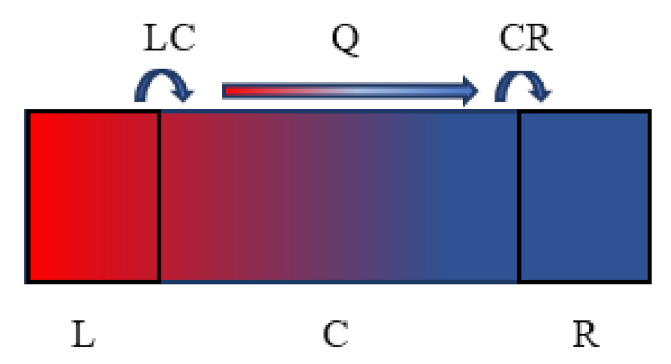
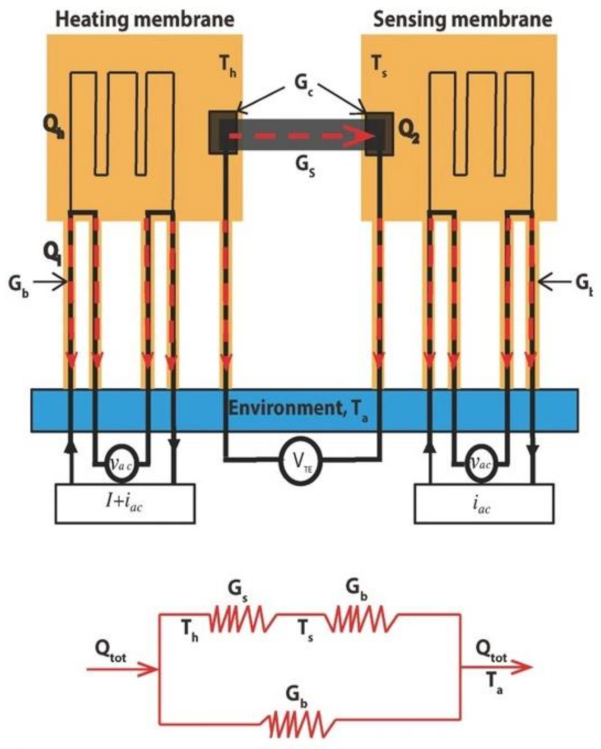
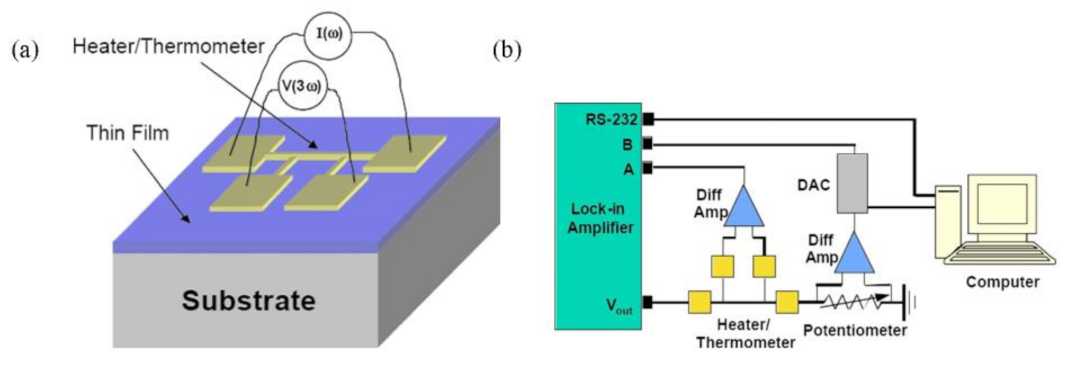
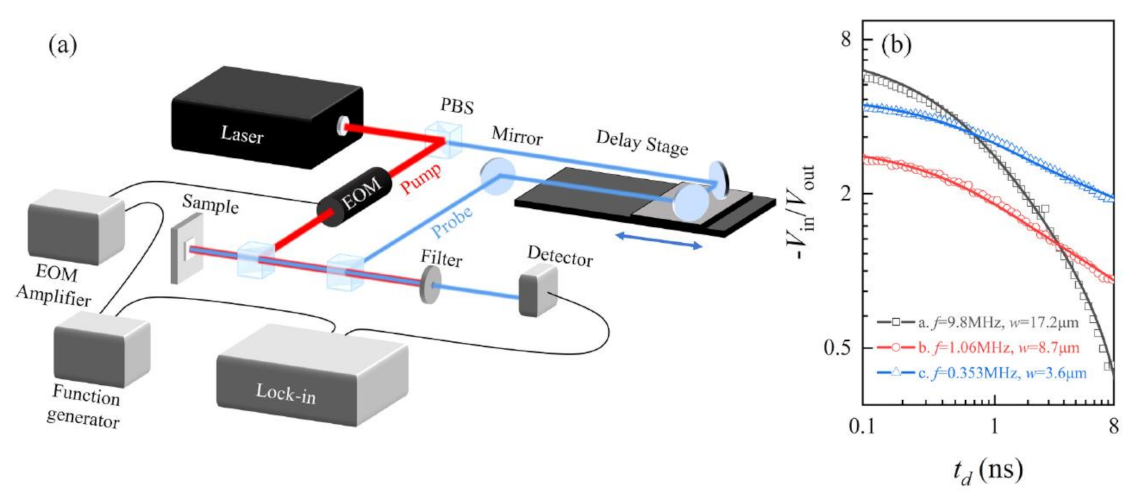
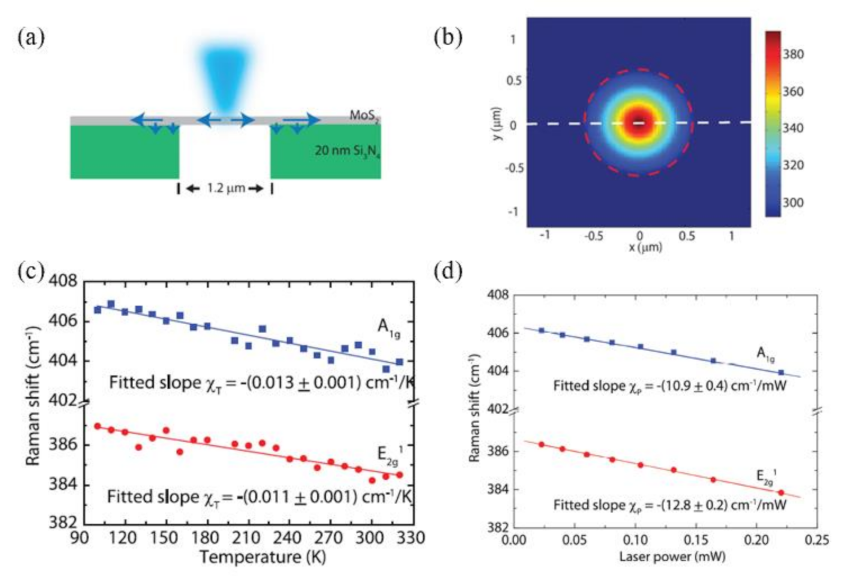
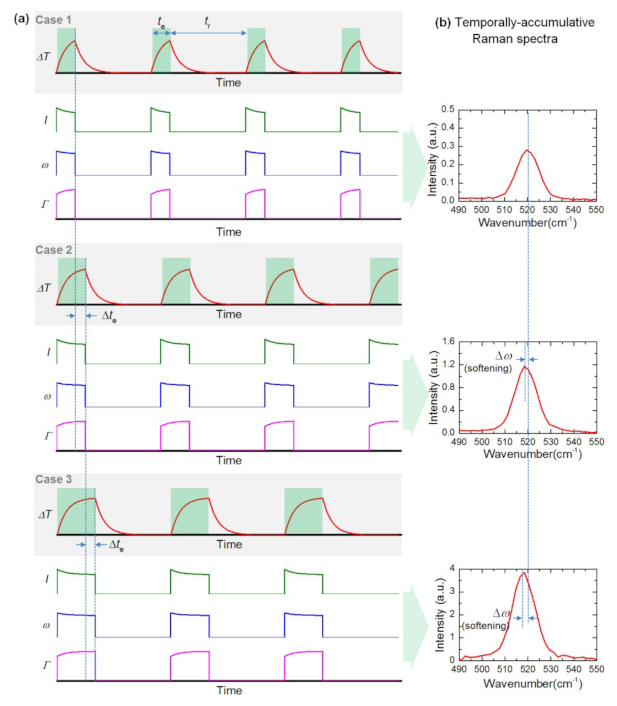

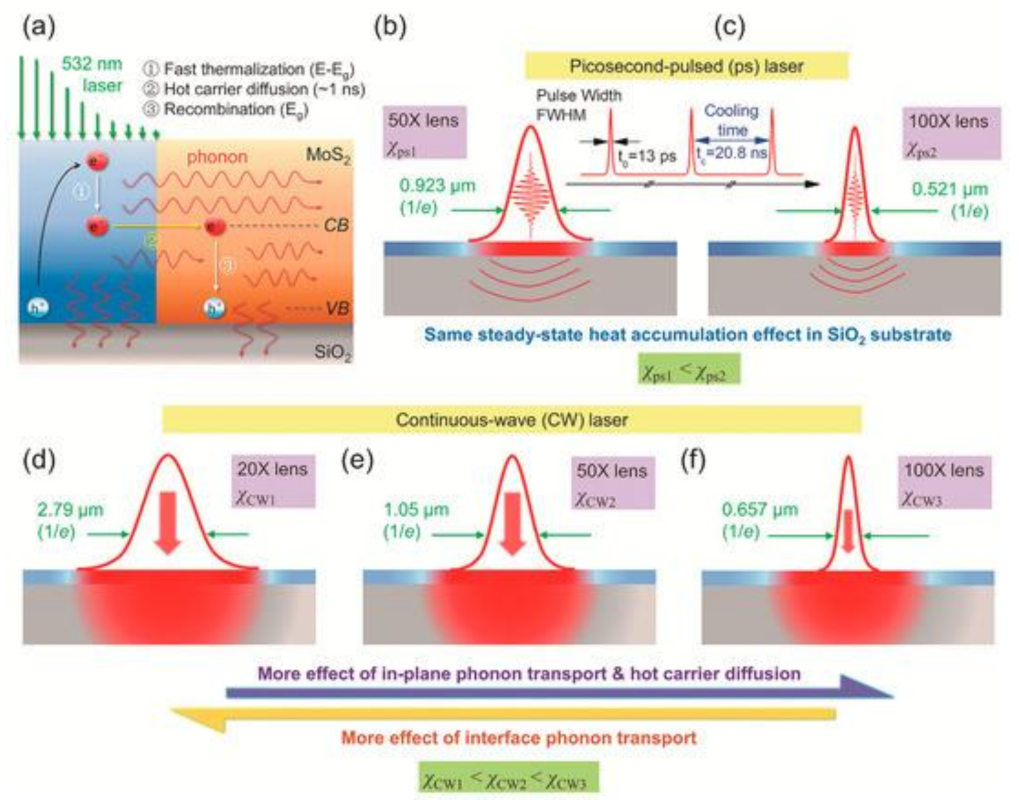

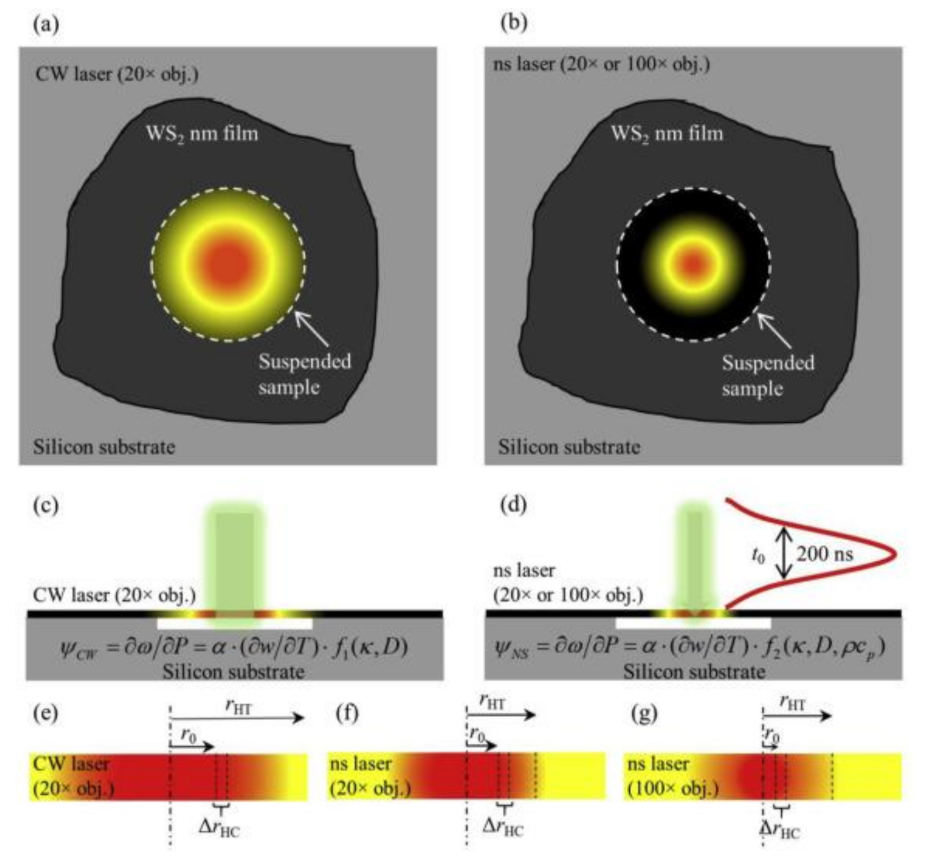

| Methods | Physical Structure of Materials | Thermal Conductivity | Limitations |
|---|---|---|---|
| Suspended Micro-Bridge | Suspended | Single-layer CVD graphene [29]: 1680 ± 180 Wm−1K−1 | Difficult micro-device preparation, existence of contact thermal resistance |
| Bilayer h-BN [30]: Wm−1K−1 | |||
| 4L MoS2 [31]: 44~50 Wm−1K−1 | |||
| 3ω | Supported | 100 nm SiN [35]: ~5 Wm−1K−1 64 nm BN [35]: ~4 Wm−1K−1 | Not applicable to few layer 2D material, deposition of metal electodes |
| TDTR | Supported | Single layer graphene 1 [46]: 636 ± 140 Wm−1K−1 | Complex experimental device, deposition of a metal film, not applicable to few layer 2D material |
| Optothermal Raman | Supported and suspended | Single layer graphene [57]: ~4840 to 5300 Wm−1K−1 | The inaccurate measurement results caused by laser absorption coefficient and temperature coefficient calibration |
| Few-layer h-BN [58]: 227 to 280 Wm−1K−1 | |||
| Single layer MoS2 [47]: 34.5 ± 4 Wm−1K−1 | |||
| ET-Raman | Supported and suspended | 55 nm MoS2 [53]: 46.9 ± 3.1 Wm−1K−1 |
Publisher’s Note: MDPI stays neutral with regard to jurisdictional claims in published maps and institutional affiliations. |
© 2022 by the authors. Licensee MDPI, Basel, Switzerland. This article is an open access article distributed under the terms and conditions of the Creative Commons Attribution (CC BY) license (https://creativecommons.org/licenses/by/4.0/).
Share and Cite
Dai, H.; Wang, R. Methods for Measuring Thermal Conductivity of Two-Dimensional Materials: A Review. Nanomaterials 2022, 12, 589. https://doi.org/10.3390/nano12040589
Dai H, Wang R. Methods for Measuring Thermal Conductivity of Two-Dimensional Materials: A Review. Nanomaterials. 2022; 12(4):589. https://doi.org/10.3390/nano12040589
Chicago/Turabian StyleDai, Huanyu, and Ridong Wang. 2022. "Methods for Measuring Thermal Conductivity of Two-Dimensional Materials: A Review" Nanomaterials 12, no. 4: 589. https://doi.org/10.3390/nano12040589
APA StyleDai, H., & Wang, R. (2022). Methods for Measuring Thermal Conductivity of Two-Dimensional Materials: A Review. Nanomaterials, 12(4), 589. https://doi.org/10.3390/nano12040589







